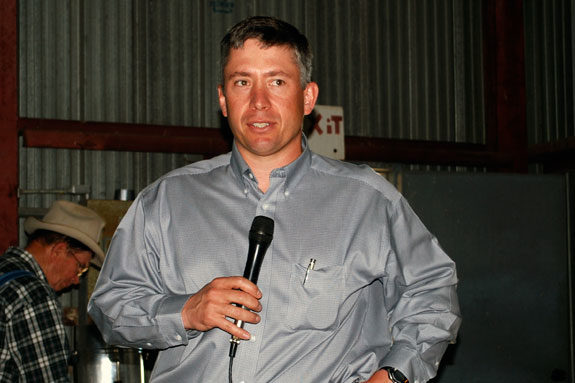Topics included switchgrass cultivars for biofuel production, wet distillers grains storage, optimizing hay quality, distillers grains as a nutrient source for grazing cattle and managing high risk calves in stocker and feeder operations.
Some take-home messages from each of the presenters were:
Dr. Lyle Lomas
Dried Distillers' Grain as a Nutrient Source for Grazing Cattle and Pastures
Steers fed 1 percent of body weight on tall fescue gained an extra 250 lb/a season-long from 0.78 tons of DDG and returned 57 lb of nitrogen/a to the pasture, replacing 60 lb N/a of fall fertilizer.
Dr. Justin Waggoner
Storage of Wet Distillers' Grains: No Bags, No Forage
They stored WDG in concrete bunker silos as received with no problems, as long as it was covered tightly to exclude oxygen.
Dr. Doug Shoup
Optimizing Hay Quality
Tips for hay quality:
1. Select forage that matches your livestock requirement.
2. Manage for that requirement.
a. Balance quantity with quality; i.e. harvest at the proper maturity.
b. Grass needs nitrogen to produce enough protein that minimizes supplementation.
3. Effects of rain damage.
a. Solubles are leached.
b. Respiration continues, reducing dry matter.
c. Leaf shatter increased with each drying-wetting cycle.
4. Storage method effects on big round bales.
a. Type of hay dictates amount of weathering; native grass less affected than tame grass, and much less than alfalfa.
b. Net wrap was slightly better than string, especially when uncovered.
Dr. Joe Moyer
Switchgrass Cultivars for Biofuel Production
The production of seven experimentals from Ceres Corporation were compared with three public varieties over a three-year period. 'Kanlow', 'Alamo' and five of the experimental cultivars produced similar yields, in excess of 5.5 tons of dry matter per acre.
Dr. Dan Thomson
Management of High-Risk Calves
When high-fatality episodes occur, the problem is usually morbidity; the case fatality ratio (number died: number treated) may be typical. It was just a matter of having to treat more.
Problems usually stem from:
- the source and condition of the calves,
- not having enough qualified personnel (or too many cattle) to properly manage the situation, and
- weather conditions adversely affecting the cattle (and the personnel).
Recognizing and dealing with these three factors will usually minimize problems. FG
PHOTOS
PHOTO 1: Dan Thomson
PHOTO 2: Justin Waggoner were two of the speakers at the Beef Cattle and Forage Crops Field Day. Photos courtesy of Doug Tourben, editor of Farm Talk newspaper.
Information provided by Dr. Joe Moyer, Research Agronomist at KSU Southeast Agricultural Research Center.











